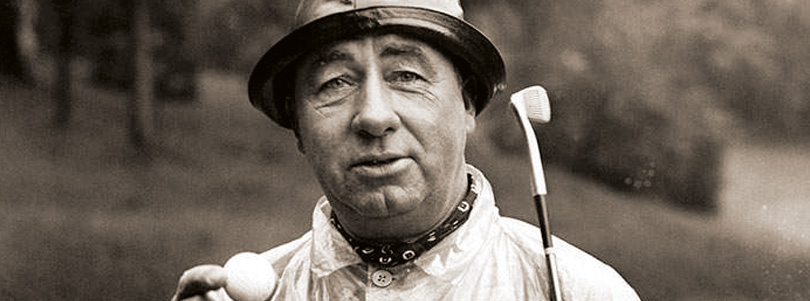Wayward Shots – Golf’s Biggest Showoff

On the final tee in the final round of The Open Championship quite a few years ago, someone told Golf’s Biggest Showoff that he trailed by two. He’d have to make an eagle two on the par-4 18th at Royal Lytham & St. Annes to tie.
The Showoff received the news without apparent emotion, then banged out a long drive down the middle. When The Open was down to the last shot and even when it wasn’t, it was hard to take your eye off this guy. While everyone else in the gallery and among the players wore tweed and earth tones, he strode like a king in cream-colored plus-two’s and a snow-white sweater. Big flat caps were the order of the day in 1926, but the showoff, Walter Hagen, was hatless, as usual, because he hated to block anyone’s view of Walter Hagen. He walked along like he owned the place. The cool summer sun glinted off his oiled hair.
Hagen arrived at his ball, looked at it, and kept walking, all the way to the green. He carefully examined the hole and the terrain around it, then instructed the referee to remove the pin. The melodrama continued as the man in white strode back up the fairway, quite aware that the stage was all his.
Did Hagen hole his shot from 155? No, but he gave the folks one last thrill: his ball landed only two feet from the jar, then rolled into a bunker over the green, and he had to settle for T-3. Bobby Jones won.
Obviously, the showoff could play. All of us know about the death match between Nicklaus and Woods for most career majors, but do you know who’s in third place? It’s Hagen, with 11, whose heyday preceded the invention of the Masters in 1934. So, if we count the Western Open as a major – which it definitely was back then – then Sir Walter owns 16 big ones; one more than Tiger and just two fewer than Jack.
Hagen was an unbelievable piece of work, a mash-up of Tiger, Arnie and an in-his-prime John Daly. We see self-assured players any time we watch the late starters on Sunday on the tour, but Hagen’s utter confidence in his ability – and the outrageous way he showed it – sets him apart. There are hundred examples, but this may be the best one:
The Showoff fell well off the pace in the 1919 U.S. Open Championship at Brae Burn in Boston but a late rally in the final round drew him close. Mike Brady, a local pro, held the lead and held a glass of something while he waited out the result in the locker room.
Hagen got his ball to within eight feet of the cup on the final hole; that would be his putt to tie.
“Go get Brady,” Hagen said. “I’ll wait.”
The tournament leader reluctantly returned to the 18th green. Hagen gave him a big smile, then knocked the putt in. There’d be a playoff the next day.
That night Sir Walter threw a pre-victory party which Brady did not attend. It got late. Someone asked the host if he should be resting because, after all, tomorrow’s opponent had been in bed for hours. Hagen delivered a line for the ages:
“Brady may be in bed,” he said. “But he ain’t sleeping.”
The punchline isn’t that Walter won the next day, it’s that he took Brady with him when he returned to Detroit for a banquet in his honor and to resume his duties as the pro at Oakland Hills Country Club. At some point during the dinner Hagen was asked to say a few words. He shocked the attendees by resigning as the OHCC pro – and shocked them again by presenting the new pro: Mike Brady! They hired him.
What Hagen did next – what he did for the rest of his life – is why he is one of the most important golf pros ever. He toured the world, giving exhibitions for $1,000 a pop. By showing off for a new audience or several of them every week, he popularized golf to a remarkable degree. All he had to do, really, was to be Walter Hagen.



